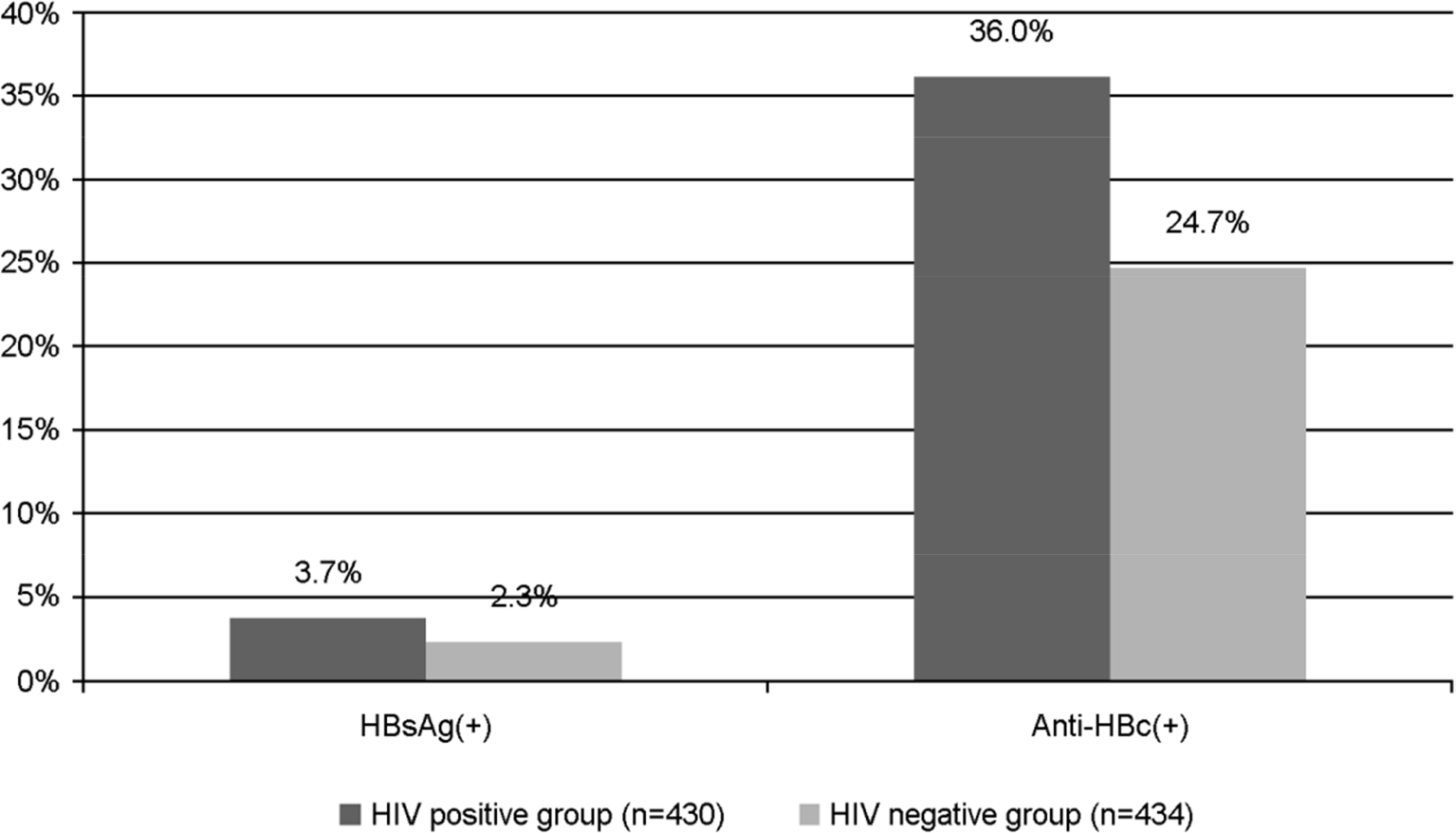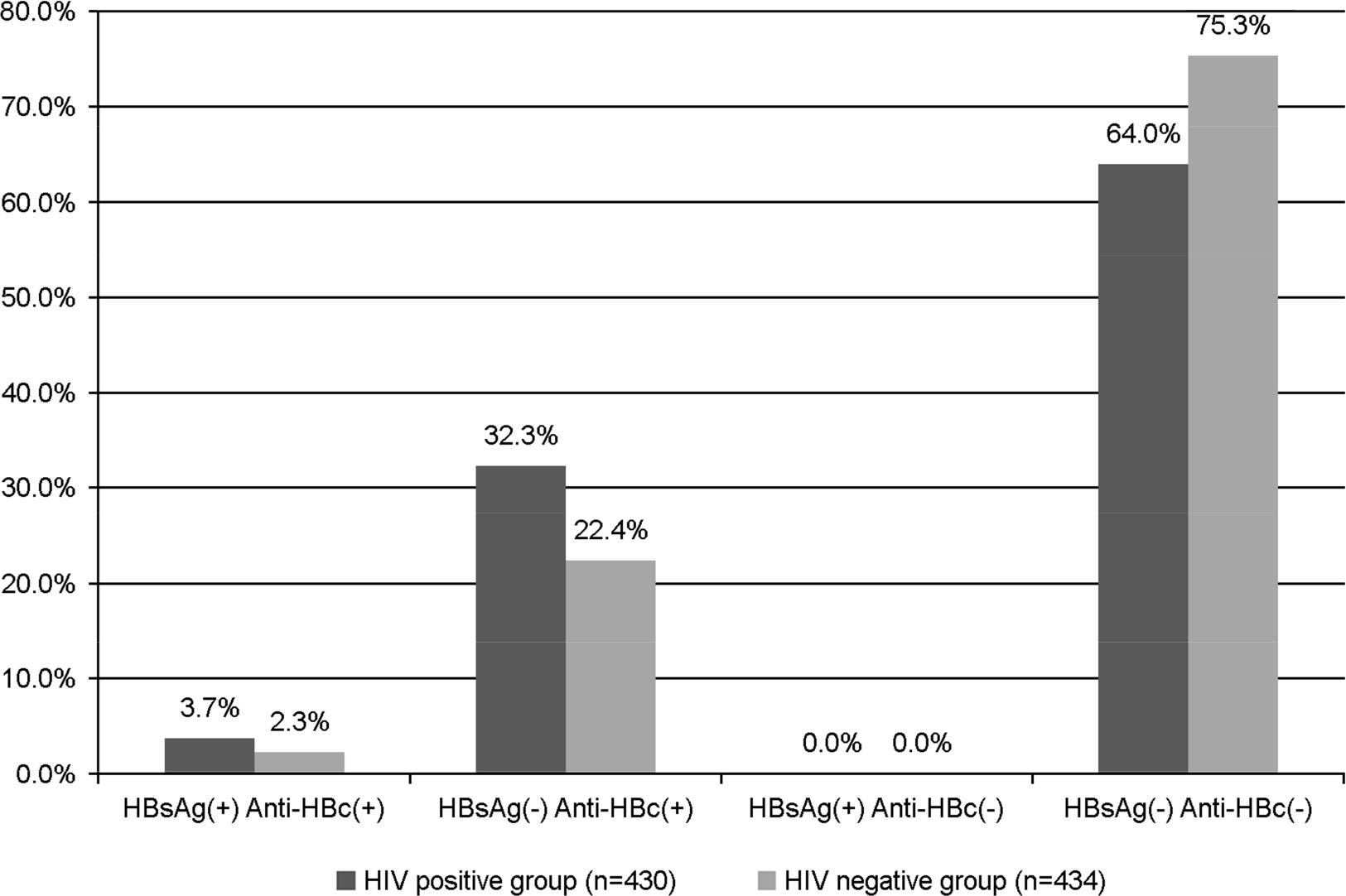Abstract
Hepatitis B virus (HBV) and human immunodeficiency virus (HIV) have a common route like sexually transmitted infections (STIs), vertical transmission and blood transfusion, etc. Therefore, it was necessary to be an attempt to confirm the relationship of HBV and HIV in Korea. We investigated the prevalence of Hepatitis B surface antigen (HBsAg) and Hepatitis B core antibody (anti-HBc) in HIV positive groups (n=430) and HIV negative groups (n=434) from January 2014 to October 2015. When comparing the prevalence of anti-HBc between the two groups, HIV positive group (36.0%) showed a higher prevalence than HIV negative group (24.7%), the result was statistically significant (p < 0.05). However, there was a little difference on HBsAg and not significant. Therefore, by showing a clear difference in anti-HBc between the two groups of HIV in Korea, it was confirmed to be associated with co-infections between Hepatitis B and HIV.
Go to : 
REFERENCES
1). Dienstag JL. Acute Viral Hepatitis. Kasper D, Fauci A, Hauser S, Longo D, Jameson J, Loscalzo J. Harrison's Principles of Internal Medicine. 19e. New York, NY: McGraw-Hill;2015.
2). Fauci AS, Lane H. Human Immunodeficiency Virus Disease: AIDS and Related Disorders. Kasper D, Fauci A, Hauser S, Longo D, Jameson J, Loscalzo J., editorsHarrison's Principles of Internal Medicine. 19e.New York, NY: McGraw-Hill;2015.
3). Alter MJ. Epidemiology of viral hepatitis and HIV co-infection. J Hepatol. 2006; 44(1 Suppl):S6–9.

4). Kim O, Kim SS, Park MS, Suh SD, Lee MW, Kim KS, et al. Seroprevalence of sexually transmitted viruses in Korean populations including HIV-seropositive individuals. Int J STD AIDS. 2003; 14:46–9.

5). Centers for Disease Control and Prevention. HIV and Viral Hepatitis fact sheet. June, 2016. http://www.cdc.gov/hiv/pdf/library/factsheets/hiv-viral-hepatitis.pdf.
6). Wu S, Yan P, Yang T, Wang Z, Yan Y. Epidemiological profile and risk factors of HIV and HBV/HCV co-infection in Fujian Province, southeastern China. J Med Virol. 2016. DOI: doi: 10.1002/jmv.24666.

7). Tsuchiya N, Pathipvanich P, Rojanawiwat A, Wickukchinda N, Koga I, Koga M, et al. Chronic Hepatitis B and C co-infection increased all-cause mortality in HAART-naïve HIV patients in Northern Thailand. Epidemiol Infect. 2013; 141:1840–8.
8). Nyirenda M, Beadsworth MB, Stephany P, Hart CA, Hart IJ, Munthali C, et al. Prevalence of Infection with hepatitis B and C virus and coinfection with HIV in medical inpatients in Malawi. J Infect. 2008; 57:72–7.

9). Desalegn Z, Wassie L, Beyene HB, Nihret A, Ebstie YA. Hepatitis B and human immunodeficiency virus co-infection among pregnant women in resource-limited high endemic setting, Addis Ababa, Ethiopia: implications for prevention and control measures. Eur J Med Res. 2016; 21:16.

10). Kallas E, Huik K, Türk S, Pauskar M, Jõgeda EL, Šunina M, et al. T cell Distribution in Relation to HIV/HBV/HCV Coinfections and Intravenous Drug Use. Viral Immunol. 2016; 29:464–70.

11). Vargas JI, Jensen D, Sarmiento V, Peirano F, Acuna P, Fuster F, et al. Presence of anti-HBc is associated to high rates of HBV resolved infection and low threshold for Occult HBV Infection in HIV patients with negative HBsAg in Chile. J Med Virol. 2016; 88:639–46.

12). Martins S, Livramento A, Andrigueti M, Kretzer IF, Machado MJ, Spada C, et al. The prevalence of hepatitis B virus infection markers and socio-demographic risk factors in HIV-infected patients in Southern Brazil. Rev Soc Bras Med Trop. 2014; 47:552–8.

13). Mudawi H, Hussein W, Mukhtar M, Yousif M, Nemeri O, Glebe D, et al. Overt and occult hepatitis B virus infection in adult Sudanese HIV patients. Int J Infect Dis. 2014; 29:65–70.

14). Rusine J, Ondoa P, Asiimwe-Kateera B, Boer KR, Uwimana JM, Mukabayire O, et al. High seroprevalence of HBV and HCV infection in HIV-infected adults in Kigali, Rwanda. PLoS One. 2013; 8:e63303.

15). Panigrahi R, Majumder S, Gooptu M, Biswas A, Datta S, Chandra PK, et al. Occult HBV infection among anti-HBc positive HIV-infected patients in apex referral centre, Eastern India. Ann Hepatol. 2012; 11:870–5.

16). Chen X, He JM, Ding LS, Zhang GQ, Zou XB, Zheng J. Prevalence of hepatitis B virus and hepatitis C virus in patients with human immunodeficiency virus infection in Central China. Arch Virol. 2013; 158:1889–94.

17). Chae HB, Kim JH, Kim JK, Yim HJ. Current status of liver diseases in Korea: hepatitis B. Korean J Hepatol. 2009; 15(Suppl 6):S13–24.

18). Hong WS, Kim CY. Seroepidemiology of type A and type B hepatitis in Seoul area. Korean J Med. 1982; 25:19–26.
19). Jang KM, Woo SH, Yun DH, Lee KR, Kwon YO, Tae KH, et al. Seroepidemiologic survey on type B viral hepatitis in Inchon area. Korean J Med. 1983; 26:1331–6.
20). Ahn YB, Mah SC. A study on the occurrence of antigen, antibody and epidemiology of hepatitis B in the life insurance company. J KLIMA. 1986; 3:163–9.
21). Jang MK, Lee JY, Lee JH, Kim YB, Kim HY, Lee MS, et al. Seroepidemiology of HBV infection in South Korea, 1995 through 1999. Korean J Intern Med. 2001; 16:153–9.
22). Joo KR, Bang SJ, Song BC, Youn KH, Joo YH, Yang SH, et al. Hepatitis B viral markers of Korean adults in the late 1990s: survey data of 70, 347 health screenees. Korean J Gastroenterol. 1999; 33:642–52.
23). Choe BH. The epidemiology and present status of chronic hepatitis B in Korean children. Korean J Pediatr. 2008; 51:696–703.

24). Chun BY, Lee MK, Rho YK. The prevalence of hepatitis B surface antigen among Korean by literature review. Korean J Epidemiol. 1992; 14:70–8.
25). Kim RK, Ahn BM, Lee DS, Lee KM, Park YM, Lee YS, et al. Changes in the positivities of HBsAg and anti-HCV antibody among army draftees in Korea. Korean J Hepatol. 2000; 6:474–80.
26). Lee DH, Kim JH, Nam JJ, Kim HR, Shin HR. Epidemiological findings of hepatitis B infection based on 1998 National Health and Nutrition Survey in Korea. J Korean Med Sci. 2002; 17:457–62.

27). Sim JG, Seo JK, Suh SJ. Prevalence and its changes of hepatitis B viral markers from 1988 to 1993 in Korean children. Korean J Pediatr. 1995; 38:1535–9.
28). Choe YH, Seo JK, Yun JH, Lee HS. Recent changes in prevalence of hepatitis B viral markers in preschool children in Seoul, 1995. Korean J Pediatr. 1996; 39:1254–9.
Go to : 
Table 1.
Prevalence of HBsAg according to periods (modified from ref. 17)
| Year | Prevalence (%) |
|---|---|
| 1979. 3 ~ 1981. 2 (18) | 6.6 |
| 1982. 4 ~ 1983. 3 (19) | 8.6 |
| 1984. 2 ~ 1985. 11 (20) | 8.3 |
| 1995. 1 ~ 1995. 12 (21) | 8.3 |
| 1995. 7 ~ 1997. 12 (22) | 5.7 |
| 1996. 1 ~ 1996. 12 (21) | 4.8 |
| 1997. 1 ~ 1997. 12 (21) | 3.4 |
| 1998. 1 ~ 1998. 12 (21) | 3.4 |
| 1999. 1 ~ 1999. 12 (21) | 2.6 |
| 2014. 1 ~ 2015.11∗ | 2.3 |




 PDF
PDF ePub
ePub Citation
Citation Print
Print




 XML Download
XML Download